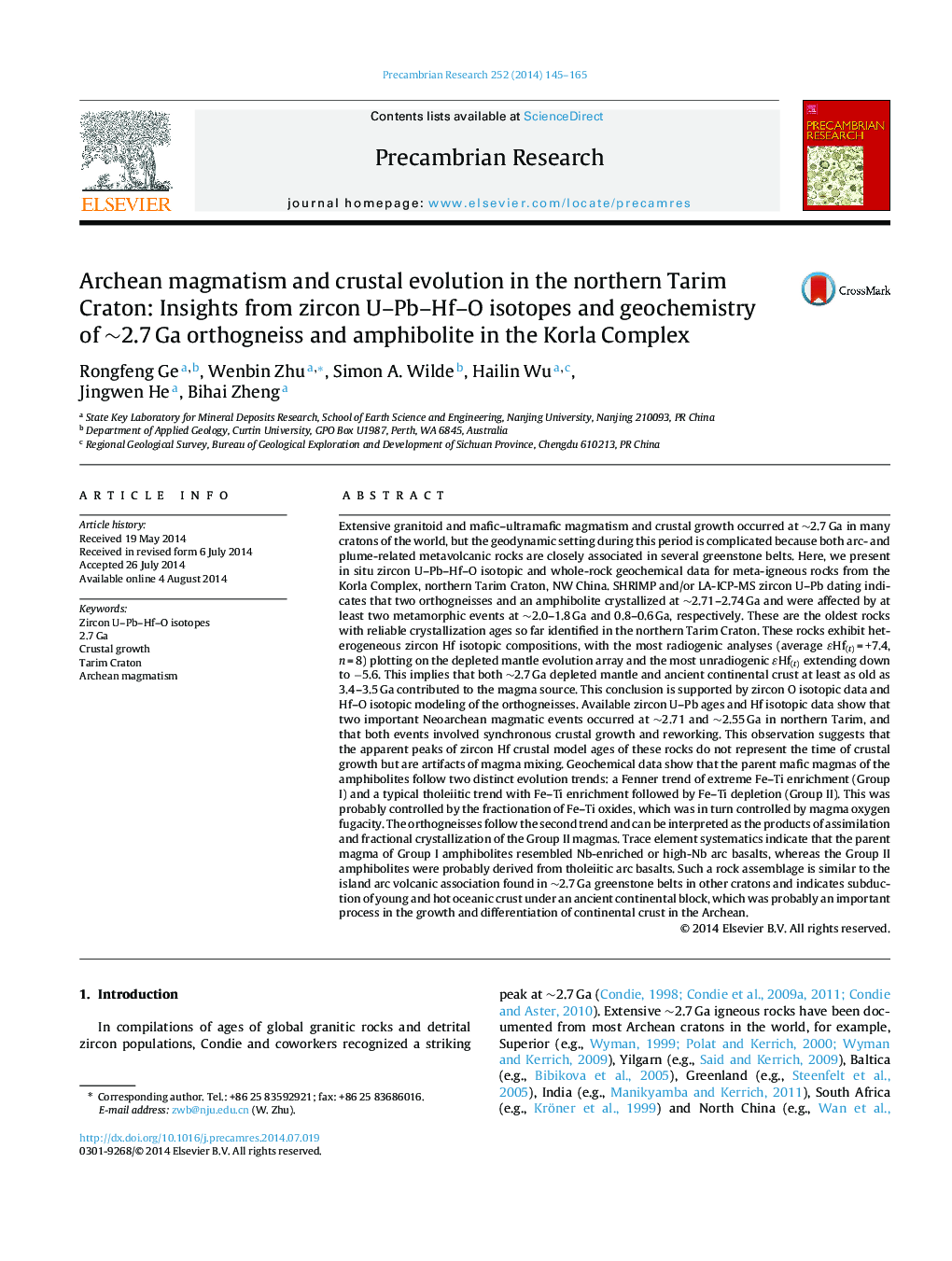| کد مقاله | کد نشریه | سال انتشار | مقاله انگلیسی | نسخه تمام متن |
|---|---|---|---|---|
| 4722951 | 1639622 | 2014 | 21 صفحه PDF | دانلود رایگان |

• Ca. 2.71–2.74 Ga orthogneisses and amphibolites were identified in the Korla Complex.
• Both depleted mantle and ancient continental crust were involved in magma genesis.
• The amphibolites originate from tholeiitic arc basalts and Nb-enriched or high-Nb arc basalts.
• Continental arcs played an important role in Archean crustal growth and differentiation.
Extensive granitoid and mafic–ultramafic magmatism and crustal growth occurred at ∼2.7 Ga in many cratons of the world, but the geodynamic setting during this period is complicated because both arc- and plume-related metavolcanic rocks are closely associated in several greenstone belts. Here, we present in situ zircon U–Pb–Hf–O isotopic and whole-rock geochemical data for meta-igneous rocks from the Korla Complex, northern Tarim Craton, NW China. SHRIMP and/or LA-ICP-MS zircon U–Pb dating indicates that two orthogneisses and an amphibolite crystallized at ∼2.71–2.74 Ga and were affected by at least two metamorphic events at ∼2.0–1.8 Ga and 0.8–0.6 Ga, respectively. These are the oldest rocks with reliable crystallization ages so far identified in the northern Tarim Craton. These rocks exhibit heterogeneous zircon Hf isotopic compositions, with the most radiogenic analyses (average ɛHf(t) = +7.4, n = 8) plotting on the depleted mantle evolution array and the most unradiogenic ɛHf(t) extending down to −5.6. This implies that both ∼2.7 Ga depleted mantle and ancient continental crust at least as old as 3.4–3.5 Ga contributed to the magma source. This conclusion is supported by zircon O isotopic data and Hf–O isotopic modeling of the orthogneisses. Available zircon U–Pb ages and Hf isotopic data show that two important Neoarchean magmatic events occurred at ∼2.71 and ∼2.55 Ga in northern Tarim, and that both events involved synchronous crustal growth and reworking. This observation suggests that the apparent peaks of zircon Hf crustal model ages of these rocks do not represent the time of crustal growth but are artifacts of magma mixing. Geochemical data show that the parent mafic magmas of the amphibolites follow two distinct evolution trends: a Fenner trend of extreme Fe–Ti enrichment (Group I) and a typical tholeiitic trend with Fe–Ti enrichment followed by Fe–Ti depletion (Group II). This was probably controlled by the fractionation of Fe–Ti oxides, which was in turn controlled by magma oxygen fugacity. The orthogneisses follow the second trend and can be interpreted as the products of assimilation and fractional crystallization of the Group II magmas. Trace element systematics indicate that the parent magma of Group I amphibolites resembled Nb-enriched or high-Nb arc basalts, whereas the Group II amphibolites were probably derived from tholeiitic arc basalts. Such a rock assemblage is similar to the island arc volcanic association found in ∼2.7 Ga greenstone belts in other cratons and indicates subduction of young and hot oceanic crust under an ancient continental block, which was probably an important process in the growth and differentiation of continental crust in the Archean.
Journal: Precambrian Research - Volume 252, October 2014, Pages 145–165